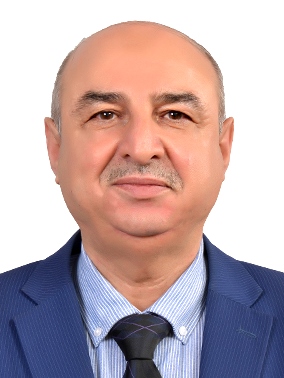
Jawdat Ali Yagoob
Research InterestsPowder metallurgy
corrosion engineering
nanomaterials
composite materials
tribology
Stir casting
biomaterials
| Gender | MALE |
|---|---|
| Place of Work | Technical Engineering College/ Kirkuk |
| Position | Lecturer |
| Qualification | Ph.D |
| Speciality | Metallurgy Engineering/Nano Materials |
| jaw209662@ntu.edu.iq | |
| Phone | 07701252461 |
| Address | Baghdad Road, -, Kirkuk, Iraq |
Biography:
I am Prof. Dr. Jawdat A. Yagoob. I am. is a professor in Engineering metallurgy in field of nano-materials at Northern Technical University, IRAQ.
I received my PhD degree from University of Technology, Baghdad – Iraq at 2019.
I received his M.Sc. degree from University of Technology, Baghdad – Iraq at 2002.
He received his B.Sc. degree form Al-Nahrain University, Baghdad- Iraq at 1988.
I Awarded 3 Patents from C.O.S.Q.C. IQ in fields of composite materials casting, bio-corrosion improvement of CoCrMo alloy, and nanofluid.
I published 38 scientific papers related to different branches of engineering metallurgy
From 2012 to 2015 I worked as Head of the Department of Refrigeration and Air Conditioning Engineering / Technical College – Kirkuk- IRAQ.
From 2019 to 2021 I worked as Head of the Department of Mechanical power technical engineering / Technical College – Kirkuk- IRAQ.
Nowadays I am preparing three patents in important fields of engineering science.
Skills
Powder metallurgy of nano-composites (100%)
Supervision
Nawal Ali Abd
Year: 2021Academic Degree: PhD
Supervisor Type: Co-supervisor
Supervisor State: Graduated
Characterization and effect of nano and micro TiC reinforcement particles on the properties of Copper matrix composites
Pari Adnan Fareek
Year: 2022Academic Degree: Master
Supervisor Type: Co-supervisor
Supervisor State: Graduated
Numerical validation of hybrid nanofluid (TiO2-ZnO//Water) mixed convection flow in a backward facing step channel
Basma Fener Sultan
Year: 2023Academic Degree: PhD
Supervisor Type: Co-supervisor
Supervisor State: Graduated
Fabrication and Characterization of Magnesium Based (AZ31) and (Mg-Zn) Composites by Powder Metallurgy for Biomedical Applications
Academic Qualification
PhD
Oct 15, 2016 - Jun 29, 2019I received my PhD degree from University of Technology, Baghdad – Iraq at 2019.
Publications
Diffusion between aluminum and iron
Jan 1, 1998Journal Tikreet University Journal of Science
publisher Tikreet University
DOI -
Issue 1
Volume 4
This study has been conducted on specimens of Iron (with no Carbon content) and Aluminum powders. The specimens produced by cold work operation, then heated at 625°C for time intervals between (3-18 hr), then slowly cooled down to R.T. The specimens microstructure photographed were examined by optical microscope. It has been observed from photographs, that increasing of heating time decreases porosity numbers and increases remained Iron powder particles in the structure, also the green strength has been increased. Photographs showed that the Iron atoms diffused in Aluminum structure directly from Iron powder particles which surrounded Aluminum particles, or from the Iron strips and small Iron grains that penetrated into the Aluminum structure. The measurement of diffusion coefficient of Iron in Aluminum at 625 °C was 1.1217 x 10-10 cm2/sec which is greater than the value of diffusion coefficient of Aluminum in Iron at the same temperature which has been measured graphically, by other authors which was 9.3 x 10-13 cm2/scc.
THE EFFECT OF SOME HEAT TREATMENTS ON THE PROPERTIES OF MEDIUM CARBON STEEL
Nov 1, 2005Journal مجلة تكريت للعلوم الهندسية
publisher Tikrit University
DOI -
Issue 4
Volume 12
The present study is aimed to compare between the effect of the modified isothermal annealing with conventional full annealing and normalizing on the properties of medium carbon steel by full annealing and normalizing tensile test and other disc like shape specimens by heating them at (860oC) for (15min); followed by slowly cooling inside furnace for the former treatment and by air cooling for the later to room temperature. The modified isothermal annealing was conducted by heating eight group of specimen ( each groups includes a tensile and a disc like shape specimen) respectively at (860oC) for (15min), then slowly cooled inside furnace to different temperatures (760,700,600,560,460,380,340,and 260) oC then each group is soaked at one of those temperatures for an (1hr), then air cooled to room temperature .Larger (σT) which exceed (800MPa) and (VHN) values of the treated specimens at (760 oC) were obtained when compared with those obtained by normalizing. While an increase was took place in value of the treated specimens ε% at (260 oC) over its value when full annealed , hence the formability was improved by treating at. (260 oC) isothermally with a reduction in consumed electric energy because of the shorter thermal cycle. Also the toughness was considered by evaluating the restricted areas under stress - strain curves. Finally the resulted variations in microstructures were observed by optical microscope
CORROSION OF COPPER WELDMENTS IN SALTY AND ACIDIC SOLUSIONS
Mar 1, 2008Journal مجلة تكريت للعلوم الهندسية
publisher Tikrit University
DOI -
Issue 1
Volume 15
The present study is conducted by exposing copper weldement specimens which were prepared by oxy-acetylene welding operation for copper tube by using tin-bronze alloy as a filler metal , to salty and acidic aqueous solutions containing respectively (0.5, 1.5 and 3) wt% NaCl and (0.5, 1 and 2) wt%H2SO4. The corrosion behavior of weldements showed a general decrease in corrosion rates in salty solutions with increasing of exposure time. The same thing happened to the weldement specimen which was exposed to the acidic solution containing (0.5) wt%H2SO4, while the corrosion rate of the weldements which exposed to the acidic solution containing (1 and 2)wt%H2SO4 was dropped during the first (288 hr) of exposure then a relative increase was observed by increasing the exposure time. Also the results of the calculated total corrosion rates (CrT) indicated higher value for the weldements exposed to acidic solution if they compared with those values obtained with salty solution for (696 hr) exposure. Furthermore; the examinations by optical microscope for the weldements indicated presence of pitting corrosion at welding zones by exposing the weldement to both salty and acidic solutions, while the general corrosion had a moderate appearance of the cupric part for weldements tested by these two solutions.
The Effect of Using Insulation on the Energy Saving in Building
Sep 1, 2010Journal مجلة تكريت للعلوم الهندسية
publisher Tikrit University
DOI -
Issue 3
Volume 17
The aim of the present study is to analyze the thermal performance of a building which is of 600 m3 size. The building is built in three different models. In the first model, walls are built with brick. In the second model, a layer of foam (Polystyrene) of 4 cm thickness has been used as an insulation layer inside walls and on the roof. In the third model, walls are constructed from two parts separated by air gap of 8 cm wide; moreover, a secondary roof is added to this model. A Qbasic program is prepared to simulate the required mathematical equations in finite difference method and the weather conditions data of Baghdad city at January, 1994. The results of the simulation showed that the ratio of the saved energy by the second and third models with respect to the first model are 29.96%, and 35.40% respectively.
Study the Wear and Friction of Free Cutting Brass Under Dry Sliding Condition
Dec 1, 2010Journal مجلة تكريت للعلوم الهندسية
publisher Tikrit University
DOI -
Issue 4
Volume 17
This research is devoted to study the wear resistance, coefficient of friction and contact temperature of free cutting brass under dry sliding wear conditions over steel counterface disc using pin-on-disc technique. Five load values 3.5, 7, 11, 15 and 20 N were used at constant sliding speed 10.4458 m.s-1 and time 30 min. An increase in wear rate and surface damage of brass specimens was observed by increasing the applied load and a transition from mild to severe wear was occurred at 11 N. A plastic deformation phenomena at macroscopical scale when applying 20 N was detected at the contact surfaces of the brass specimens. The average of the measured contact temperatures of brass was increased from 94 to 268 oC by increasing the applied load from 3.5 to 20 N, while the smallest and greatest calculated kinetic friction coefficient for the sliding pair( free cutting brass / steel) was 0.49 and 0.67 at applied loads 7 and 20 N respectively. Furthermore, an important observations were revealed which includes oxidation and dezincification of the wear rate and contact temperature measuring specimens respectively at their external surface contacting the iron housing far from their contact surfaces with steel disc at 20 N applied load.
STUDY THE EFFECT OF COOLING RATE ON SOME PROPERTIES AND WEAR OF BRASS
Jan 1, 2012Journal مجلة التقني
publisher هيئة التعليم التقني
DOI -
Issue 5
Volume 25
This research is devoted to study the effect of cooling rate on surface hardness; microstructure and wear of brass type (C 26800) under dry sliding conditions, where cooling rate rapidity was controlled by changing the used casting mould wall thickness and type. It has been observed increasing of the surface hardness of castings by increasing cooling rate and occurrence of differences in the fashion of the microstructures and their grain size by varying cooling rate. Also the wear of yellow brass over steel disc using pin-on-disc technique has been studied. An increase in wear rate and surface damage of brass was observed also by decreasing the cooling rate. Key words: Cooling rate,Wear of yellow brass, Microstructure of yellow brass.






